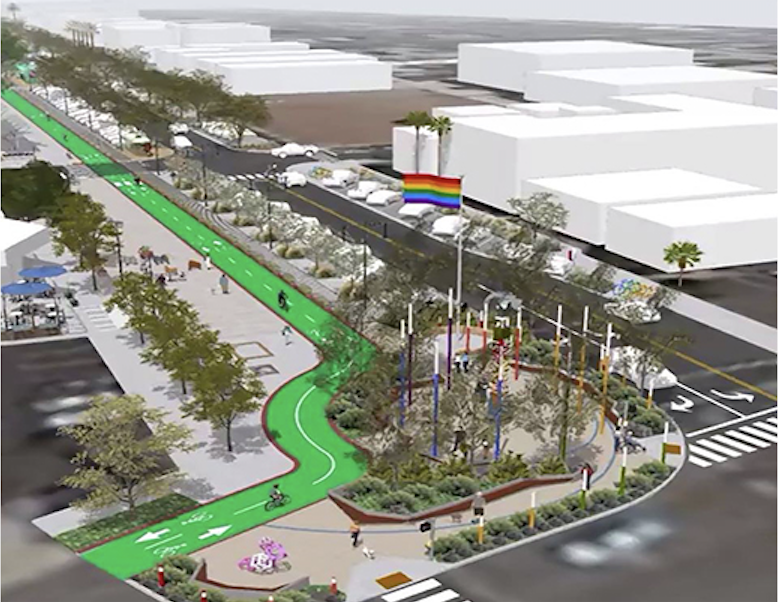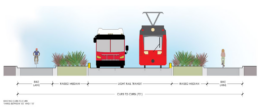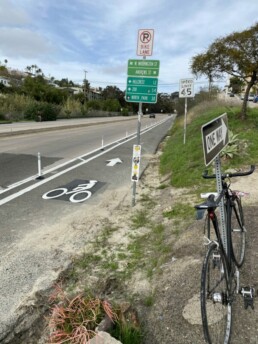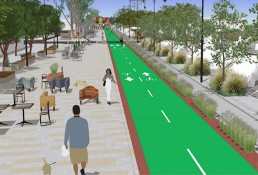BikeSD Voices: An Open Letter I Sent to the Planners behind the Hillcrest Plan Amendment
BikeSD Voices: An Open Letter I Sent to the Planners behind the Hillcrest Plan Amendment
Author: Nevo Magnezi
I recently attended the Uptown Planners Plan Hillcrest subcommittee meeting, Mobility Network Concepts, on June 30th. Or in plainspeak, planners and consultants from the city presented to community members and board members (appointed from Uptown Planners) transportation concepts that will be incorporated as part of the upcoming Community Plan Update for Hillcrest. You can learn more about this process on their website, and can see the slide deck they presented on June 30th, which I based my response on, here: Hillcrest CPG – Mobility June 2022 PDF
As someone who has been advocating for better mobility for several years, I wanted to provide new advocates an example of some of the key points I make. Admittedly, this isn’t one of my best worded emails (more like my manic midnight brain talking), but I thought it could be useful regardless.
Feel free to take my email as an inspiration to write your own with regards to mobility in Hillcrest.
Dear Ms. Mulderig, Ms. Brizuela, and Ms. Chen,
My name is Nevo Magnezi. I live in Hillcrest (have lived in both the east and southwestern portions of the plan focus area) and have been attending the Plan Hillcrest subcommittee meetings more or less since they began. I also volunteer for Bike San Diego.
I am reaching out because I’d like to provide some feedback on the most recent presentation. I am grateful for the visioning and options that the city and Chen Ryan Associates are providing and I think that whatever the outcome, it will be an improvement over the status quo.
My main concern is that planners were too quick to abandon the idea of envisioning University Ave as an active transportation and transit corridor. There are many examples around the world, the country, and, once the Gaslamp Promenade is implemented downtown, even the city, of walkable commercial corridors with very limited private automobile access, other than emergency vehicles and deliveries during specified hours.
One of my favorite examples is of the Jerusalem Light Rail, which you can see in this video: https://www.youtube.com/watch?
By recommending a vehicle network that retains general vehicle access to University Ave, I fear you will be robbing residents and visitors of the urban linear park experience that you are advocating for in other parts of the plan. The issues you identified in the presentation will certainly need to be addressed at the time of implementation, but are, for the most part, not major issues.
Your presentation claims that Option 1 would eliminate access to Fire Station No 5. Most emergency calls (65 percent) are for medical events– eliminating fast-moving traffic that cause serious injuries and fatalities and promoting a healthy lifestyle through urban design is one of the best ways that urban planners can reduce the number of emergency calls made in the first place. But even beyond that, I hypothesize that even under Option 2, emergency responders would be more likely to use the transit lanes over the general vehicle lanes anyways due to the fact that the transit lanes will, by design, should see no congestion. It seems to me very backwards that we would need to maintain high speed vehicle access so the ambulance can get to us quickly after we are run over by a vehicle that’s there because we needed vehicle only access for the ambulance. I claim to be no expert on the considerations of emergency vehicle response times in people-centric streets, but I would like to share this resource I found on the NACTO website “Best Practices: Emergency Access in Healthy Streets.”
Three of your major issues are regarding traffic circulation and congestion. It sounds like you are taking an older Level Of Service approach towards the plan area rather than a reducing Vehicle Miles Traveled approach. In the same plan, you include light and commuter rail and low stress protected bikeways. Under these schemes, people will be moved by walking, biking and transit facilities by a factor that will dwarf the number of people moving by private automobile. If transit headways or signal timing for bikeways are not considerations of the plan amendment, then why should vehicle congestion on nearby freeways be? This approach fundamentally favors the status quo and will not allow San Diego to achieve its climate action or Vision Zero goals. Caltrans is one of the agencies responsible for 55 percent of San Diego GHG emissions coming from cars and maintain right-of-way that is responsible for countless collisions that affect vulnerable road users. The fact that even basic painted bike lanes disappear when going over their right-of-way, such as University Ave over SR-163, shows how much contempt that they hold for my life and the life of anyone not in a car. Congestion on SR-163 on-ramps cannot and should not be a concern for the Hillcrest Plan.
Finally, there is the issue of deliveries. If the Gaslamp Promenade, which is being planned and funded as we speak, can already claim per their website that “the Gaslamp Promenade will be open for deliveries from 3:00 a.m. – 11:00 a.m., seven days a week,” then why are deliveries a barrier to implementation for our long-term planning just two miles away? With deliveries, and with all of these points, the Gaslamp Promenade sets an important San Diego precedent (since we seem so eager to disregard examples from any city other than our own). If a Gaslamp Promenade, then why not a Hillcrest Promenade?
My next concern is regarding the recommended Bicycle Network. As I stated during my comment, sharrows don’t do anything. This isn’t just my perspective. According to a 13 year study of a dozen cities, it is safer to not have them at all. I am grateful that planners were able to minimize them from the recommended plan in favor of other facilities, but I would also strongly encourage the amended plan not to have them at all. Instead, it would be better to designate them all as “Enhanced Class III- Bike Boulevards.” This would reinforce to those implementing the plans to not simply “slap a sharrow on it,” but rather implement true traffic calming. I think it’s also important to qualify both these and all bicycle boulevards that the street must be designed (per NACTO), to be with a target vehicle speed of less than 20mph and volume of less than 2000 ADT, or target speed of 25mph and less than 1500 ADT.
For places where you don’t intend for those speeds and volumes, such as Sixth Ave and parts of First Ave, it is negligent to suggest that no bike facilities (which is what sharrows are) are sufficient. This is an area slated for a lot of development, and connects directly to San Diego’s Crown Jewel, Balboa Park, in the case of Sixth Ave, or a massive medical complex with tens of thousands of employees, in the case of First Ave. I strongly encourage you to include Class IV facilities as part of the plan, or simply acknowledge that you intend hardly anyone to feel safe and comfortable biking there at all.
Regarding the planned Class II – bike lane facilities, I think it is also important to qualify these with the point that they are only appropriate for streets with target speeds of 25mph or less and volumes less than 6000 ADT. In the example of Robinson Ave, this would imply that the target speed would be reduced from 30mph to 25mph, if the plan were to be implemented today. Robinson Ave between Tenth Ave and Park Blvd is also a wide street with low-volumes, and can be difficult to cross as a pedestrian. I think it would be a great candidate for the extension of the Landis-style roundabout treatment that SANDAG completed east of Park Blvd, and that will connect to Robinson Ave in Hillcrest via an elevated path.
Thank you again for your work. I realize that my email is a bit more long-winded than I intended, but I would appreciate a discussion regarding any or all of the above points.
Sincerely,
Nevo Magnezi
Hillcrest Resident
See what its like to ride the notorious Washington Street uphill
BikeSD Advocates Ride Washington Street, not for fun
After a 65 year old cyclist was killed in a hit and run accident, BikeSD has been working to address Uptown bicycle route safety and get a previously deleted bike lane restored. In the first few seconds of this video its easy to see how the dangerous design of this roadway resulted in death. Our team had a few close calls themselves.
The current Class III painted “sharrows” in the second eastbound travel lane are not recommended by the State of California for speed limits above 35 MPH. However the posted speed limit is 45 MPH, and in the video cars can be seen travelling 55 MPH or more, with some motorists even exceeding 70 MPH. Forcing bicyclists into dangerous, high-speed traffic on a steep incline like this is a recipe for disaster. The City is also not notifying motorists that the road contains a bike lane, as the signage that was posted on the hillside has been removed, and the street cycling symbol on the road has been painted over. Along with being a designated ‘Bike Route’, Washington Street is the main connector to the Washington Street Trolley Station for residents of Mission Hills, Hillcrest and Bankers Hill.
We sent a letter to the Mayor asking the city to immediately address public safety hazards on the Uptown bicycle route at eastbound Washington Street and return the Class II bicycle facility on the south side of the road. We will continue to ask that the City prioritize residents’ lives and well-being over a dozen free parking spaces.
Help us restore the Washington Street bike lane until the completion of the SANDAG Washington Street Bikeway in this area. Contact your councilmember or the mayor’s office and tell them to restore the bike lane on Washington Street.
MEDIA ADVISORY: Advocates Call on Mayor Faulconer and City of San Diego to Replace Painted Over Bike Lane After Hit & Run
FOR PLANNING PURPOSES: Wednesday, September 2, 2020 at 11 AM
MEDIA CONTACT: Kyle Heiskala
Phone: (619) 300-9484
Email: director@bikesd.org
M E D I A A D V I S O R Y
Advocates Call on Mayor Faulconer and City of San Diego to Replace Painted Over Bike Lane After Hit & Run
WHAT: Press conference with bicycle safety advocates to call on the City of San Diego and Mayor Faulconer to immediately address the dangerous situation on Washington Street and to replace a bike lane which was painted over to add parking. As a result of the existing unsafe conditions, a 66-year old bicyclist riding eastbound on Washington on August 21st, 2020 was struck by a car and critically injured and the driver fled the scene.
WHO: Bicycle Advocacy Organization Representatives
-
BikeSD
-
San Diego County Bicycle Coalition
-
San Diego Mountain Biking Association
WHEN: Wednesday, September 2, 2020, at 11:00 am
WHERE: 3754 Columbia St, San Diego, CA 92103 - Intersection of Columbia St and Andrews St
More information: The bike lane symbols formerly in this location were painted over to add free street parking. As a result, a 66-year old bicyclist riding eastbound on Washington on August 21st, 2020 was struck by a car and critically injured and the driver fled the scene. View SDPD video on Twitter here: https://twitter.com/SanDiegoPD/status/1297338194921320448?s=20
Last year, 44 pedestrians, bicyclists, and vehicle and motorcycle drivers lost their lives unnecessarily on San Diego streets and six bicyclists have been hit since 2012 near the Washington St and India St intersection. The current Class III painted “sharrows” in the second eastbound travel lane are not recommended by the State of California for speed limits above 35 MPH. However, the posted speed limit is 45 MPH, and a speed study of the corridor showed traffic speeds averaging 55 MPH or more, with some motorists traveling 70 MPH.
BikeSD https://bikesd.org/ | San Diego County Bicycle Coalition https://sdbikecoalition.org/
San Diego Mountain Biking Association https://sdmba.com/
###
DownloadLetter Sent to the Mayor to Support a Safe Bicycle Facility on Washington Street
Dear Mayor Kevin Faulconer & City Staff,
We request the City of San Diego immediately address the public safety hazard on eastbound Washington Street (east of India Street) by returning the Class II bicycle facility to the breakdown lane on the south side of the road. The bike lane symbols formerly in this location were painted over without City permission, to add free street parking. As a result, a 66-year old bicyclist riding eastbound on Washington on August 21st, 2020 was struck by a car and critically injured and the driver fled the scene.
This segment of Washington was identified by the City as a “High Priority Bicycle Project” in the 2013 Bicycle Master Plan, and is a designated City bike route. SANDAG also identified the Washington Street Bikeway in its 2012 Early Action Plan, but opposition to the Bikeway from local business districts necessitated costly studies and additions to the project, delaying Bikeway construction until 2022.
The current Class III painted “sharrows” in the second eastbound travel lane are not recommended by the State of California for speed limits above 35 MPH. However the posted speed limit is 45 MPH, and a speed study of the corridor showed traffic speeds averaging 55 MPH or more, with some motorists even exceeding 70 MPH. The City is forcing bicyclists into dangerous, high-speed traffic on a steep incline. Further, the City is not notifying motorists that the road contains a bike lane, as the signage that was posted on the hillside has been removed, and the street cycling symbol on the road has been painted over. Washington Street is the main connector to the Washington Street Trolley Station for residents of Mission Hills, Hillcrest and Bankers Hill. The City of San Diego’s requirement to reduce vehicle miles travelled, and its Climate Action Plan and Vision Zero goals are further reasons to address this corridor’s safety hazards, where six bicyclists have been hit since 2012.
We ask that the City prioritize residents’ lives and well-being over a dozen free parking spaces. Please restore the Washington Street bike lane until the completion of the SANDAG Washington Street Bikeway in this area.
Sincerely,
Normal Street Promenade Workshop - Thursday, January 24, 6:00 PM

The Normal Street Promenade will be a new public space in Hillcrest along Normal Street between University Avenue and Washington Street and will be the first transit-oriented pedestrian promenade in San Diego.
 To develop the final concept, the City of San Diego and SANDAG will work with the community through a series of workshops. The conference room at Joyce Beers Community Hall will have different stations showing the bare bones concept and then a visual preference station showing options for lighting, landscaping, etc.
To develop the final concept, the City of San Diego and SANDAG will work with the community through a series of workshops. The conference room at Joyce Beers Community Hall will have different stations showing the bare bones concept and then a visual preference station showing options for lighting, landscaping, etc.
The first workshop will be held:
DATE: Thursday, January 24th
TIME: 6:00-9:00 p.m.
LOCATION: Joyce Beers Hall, 3900 Vermont St, San Diego
Please be sure to join fellow residents and learn more about this upcoming project. More background on our earlier report on the Normal Street Promenade here.




